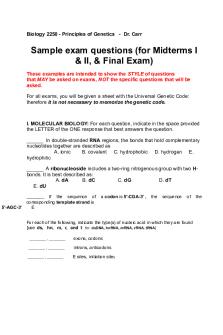Evolution exam questions PDF

| Title | Evolution exam questions |
|---|---|
| Course | Biology - A1 |
| Institution | Sixth Form (UK) |
| Pages | 3 |
| File Size | 174.7 KB |
| File Type | |
| Total Downloads | 93 |
| Total Views | 128 |
Summary
Biology practice exam questions on Evolution....
Description
Q1. Darwin’s theory of evolution states that all species of living things have evolved from simple life forms. Darwin’s theory was published in 1859. (a)
Give two reasons why Darwin’s theory was only slowly accepted. Darwin’s theory challenged the belief that God created all organisms. At that time, many people were very religious. Also, there was no evidence of genes and the mechanism of inheritance was not known at the time so scientists felt that there was insufficient evidence to back up his theory. (2)
(b)
Darwin observed birds called finches on the Galapagos Islands, 1000 km from the coast of South America. He saw that the birds were similar to, but not the same as, birds he had seen on the mainland of South America. Recent evidence suggests that 13 different species of finch on the islands evolved from 1 species of finch that arrived from the mainland about 1 million years ago. Describe how a new finch species may have evolved from the original species of finch that arrived from the mainland. The finches on the Galapagos Islands separated which caused genetic variation. So the finches with the desired genes that would allow them to survive in their environment was passed onto the offspring. After many generations of offsprings, the desired gene would be constant through all of the species so they don’t need to breed anymore. (4)
(c)
The diagram below shows the evolutionary tree for some Galapagos finches.
(i) Page 1 of 3
Which type of present-day finch is least closely related to all the others?
Vegetarian finch (1)
(ii)
Which branching point, P, Q, R or S, on the diagram above shows the most recent common ancestor of all the tree finches?
R Write the correct answer in the box. (1)
(iii)
Which two finches have the most recent common ancestor? 1. Woodpecker finch 2. Mangrove finch (1) (Total 9 marks)
Q2. The image below shows: •
Phiomia, an ancestor of elephants
•
a modern African elephant.
Phiomia lived about 35 million years ago. Phiomia
African elephant
© Dorling Kindersley via Thinkstock
Both Phiomia and the African elephant reach up into trees to get leaves. In the 1800s, Darwin and Lamarck had different theories about how the long nose of Phiomia evolved into the trunk of the African elephant. (a)
(i)
Use Darwin’s theory of natural selection to explain how the elephant’s trunk evolved. There was variation in the population of Phiomia. The Phiomia’s with the longer noses managed to get more leaves from trees and they survived. Then, they passed their desired characteristics/genes to the offspring which allowed the offspring to be able to survive in their environment. (4)
Page 2 of 3
(ii)
Lamarck’s theory is different from Darwin’s theory. Use Lamarck’s theory to explain how the elephant’s trunk evolved. When Phiomia would want food, it would stretch its nose to reach the leaves on the trees. This then passed the gene of the long nose to the offspring so that when the offspring is born, it has a long nose too. (2)
(b)
(i)
In the 1800s, many scientists could not decide whether Lamarck’s theory or Darwin’s theory was the right one. Give two reasons why. 1. Many people were very religious and believed that God made all creations so they didn’t support their theories. 2. There was insufficient evidence to prove their theories. (2)
(ii)
Before the 1800s, many people had a different idea to explain where all the living things on Earth came from. What idea was this? God made all creationism. (1) (Total 9 marks)
Page 3 of 3...
Similar Free PDFs

Evolution exam questions
- 3 Pages

Evolution exam 1
- 6 Pages

Evolution Exam 1 Study Guide
- 11 Pages

Evolution
- 2 Pages

Evolution
- 7 Pages

Evolution
- 34 Pages

Exam, questions
- 1 Pages

Exam Questions
- 9 Pages

Exam, questions
- 7 Pages

Exam, questions
- 9 Pages

Exam, questions
- 62 Pages

Exam, questions
- 8 Pages

Exam, questions
- 5 Pages

Exam, questions
- 5 Pages

Exam, questions
- 2 Pages

Exam, questions
- 10 Pages
Popular Institutions
- Tinajero National High School - Annex
- Politeknik Caltex Riau
- Yokohama City University
- SGT University
- University of Al-Qadisiyah
- Divine Word College of Vigan
- Techniek College Rotterdam
- Universidade de Santiago
- Universiti Teknologi MARA Cawangan Johor Kampus Pasir Gudang
- Poltekkes Kemenkes Yogyakarta
- Baguio City National High School
- Colegio san marcos
- preparatoria uno
- Centro de Bachillerato Tecnológico Industrial y de Servicios No. 107
- Dalian Maritime University
- Quang Trung Secondary School
- Colegio Tecnológico en Informática
- Corporación Regional de Educación Superior
- Grupo CEDVA
- Dar Al Uloom University
- Centro de Estudios Preuniversitarios de la Universidad Nacional de Ingeniería
- 上智大学
- Aakash International School, Nuna Majara
- San Felipe Neri Catholic School
- Kang Chiao International School - New Taipei City
- Misamis Occidental National High School
- Institución Educativa Escuela Normal Juan Ladrilleros
- Kolehiyo ng Pantukan
- Batanes State College
- Instituto Continental
- Sekolah Menengah Kejuruan Kesehatan Kaltara (Tarakan)
- Colegio de La Inmaculada Concepcion - Cebu